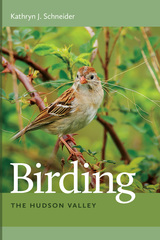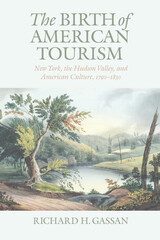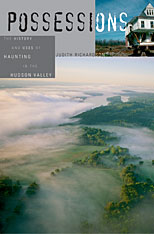3 books about Hudson Valley

Birding the Hudson Valley
Kathryn J. Schneider
University Press of New England, 2018
Although an estimated four hundred thousand Hudson Valley residents feed, observe, or photograph birds, the vast majority of New Yorkers enjoy their birdwatching activities mostly around the home. Kathryn J. Schneider’s engaging site guide provides encouragement for bird enthusiasts to expand their horizons. More than just a collection of bird-finding tips, this book explores Hudson Valley history, ecology, bird biology, and tourism. It describes sites in every county in the region, including farms, grasslands, old fields, wetlands, orchards, city parks, rocky summits, forests, rivers, lakes, and salt marshes. Designed for birders of all levels of skill and interest, this beautifully illustrated book contains explicit directions to more than eighty locations, as well as useful species accounts and hints for finding the valley’s most sought-after birds.
[more]

The Birth of American Tourism
New York, the Hudson Valley, and American Culture, 1790-1835
Richard H. Gassan
University of Massachusetts Press, 2008
Today the idea of traveling within the United States for leisure purposes is so commonplace it is hard to imagine a time when tourism was not a staple of our cultural life. Yet as Richard H. Gassan persuasively demonstrates, at the beginning of the nineteenth century travel for leisure was strictly an aristocratic luxury beyond the means of ordinary Americans. It wasn't until the second decade of the century that the first middle-class tourists began to follow the lead of the well-to-do, making trips up the Hudson River valley north of New York City, and in a few cases beyond. At first just a trickle, by 1830 the tide of tourism had become a flood, a cultural change that signaled a profound societal shift as the United States stepped onto the road that would eventually lead to a modern consumer society.
According to Gassan, the origins of American tourism in the Hudson Valley can be traced to a confluence of historical accidents, including the proximity of the region to the most rapidly growing financial and population center in the country, with its expanding middle class, and the remarkable beauty of the valley itself. But other developments also played a role, from the proliferation of hotels to accommodate tourists, to the construction of an efficient transportation network to get them to their destinations, to the creation of a set of cultural attractions that invested their experience with meaning. In the works of Washington Irving and James Fenimore Cooper and the paintings of Thomas Cole and others of the Hudson River School, travelers in the region encountered the nation's first literary and artistic movements. Tourism thus did more than provide an escape from the routines of everyday urban life; it also helped Americans of the early republic shape a sense of national identity.
According to Gassan, the origins of American tourism in the Hudson Valley can be traced to a confluence of historical accidents, including the proximity of the region to the most rapidly growing financial and population center in the country, with its expanding middle class, and the remarkable beauty of the valley itself. But other developments also played a role, from the proliferation of hotels to accommodate tourists, to the construction of an efficient transportation network to get them to their destinations, to the creation of a set of cultural attractions that invested their experience with meaning. In the works of Washington Irving and James Fenimore Cooper and the paintings of Thomas Cole and others of the Hudson River School, travelers in the region encountered the nation's first literary and artistic movements. Tourism thus did more than provide an escape from the routines of everyday urban life; it also helped Americans of the early republic shape a sense of national identity.
[more]

Possessions
The History and Uses of Haunting in the Hudson Valley
Judith Richardson
Harvard University Press, 2003
The cultural landscape of the Hudson River Valley is crowded with ghosts--the ghosts of Native Americans and Dutch colonists, of Revolutionary War soldiers and spies, of presidents, slaves, priests, and laborers. Possessions asks why this region just outside New York City became the locus for so many ghostly tales, and shows how these hauntings came to operate as a peculiar type of social memory whereby things lost, forgotten, or marginalized returned to claim possession of imaginations and territories. Reading Washington Irving's stories along with a diverse array of narratives from local folklore and regional writings, Judith Richardson explores the causes and consequences of Hudson Valley hauntings to reveal how ghosts both evolve from specific historical contexts and are conjured to serve the present needs of those they haunt. These tales of haunting, Richardson argues, are no mere echoes of the past but function in an ongoing, contentious politics of place. Through its tight geographical focus, Possessions illuminates problems of belonging and possessing that haunt the nation as a whole.
[more]
READERS
Browse our collection.
PUBLISHERS
See BiblioVault's publisher services.
STUDENT SERVICES
Files for college accessibility offices.
UChicago Accessibility Resources
home | accessibility | search | about | contact us
BiblioVault ® 2001 - 2024
The University of Chicago Press









